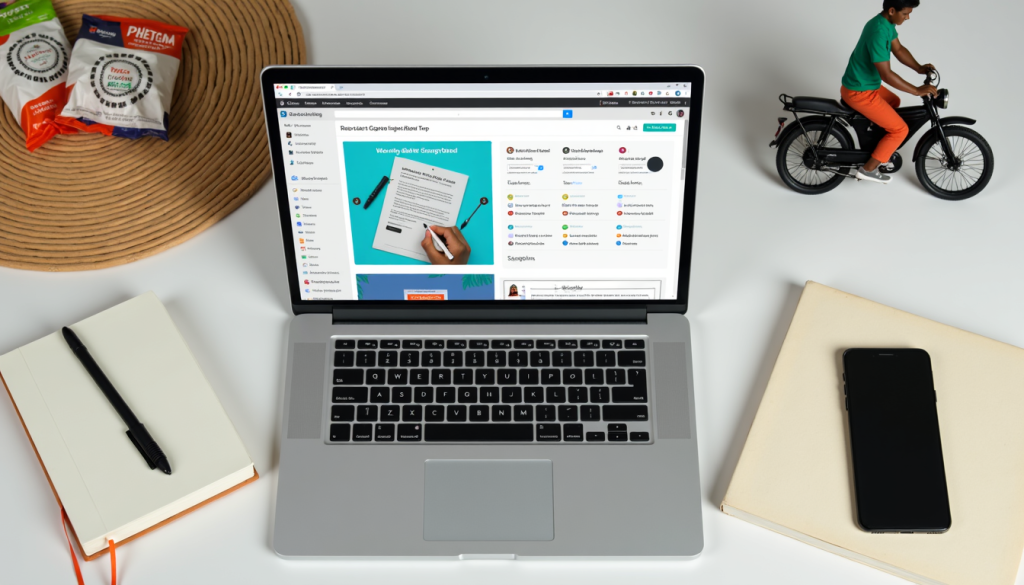The Digital Shift: A Quiet Revolution
It didn’t start with a government program or a tech giant’s announcement. It started with a student in Davao selling her digital planner on Etsy.
A mom in Cebu creating Canva templates for teachers. A freelancer in Iligan offering online courses on Upwork.
These stories aren’t rare anymore. They’re multiplying. In 2025, the Philippines is witnessing a quiet revolution—one where digital products are becoming the new livelihood, the new creative outlet, and the new path to freedom.
From Physical to Digital: A Cultural Transition
Filipinos have always been entrepreneurial. The sari-sari store is a symbol of that spirit—small, local, personal. But now, the sari-sari store has gone online. Instead of selling snacks and soap, people are selling:
- E-books on budgeting, parenting, and mental health
- Digital art and stickers for messaging apps
- Online courses on freelancing, cooking, and even K-pop dance tutorials
- Notion templates for productivity and journaling
- Subscription-based newsletters on local politics, wellness, and tech
This shift isn’t just about convenience. It’s about identity.
Filipinos are redefining what it means to be a creator. No longer limited by geography or capital, they’re building businesses from their phones, reaching audiences across the globe.

The Rise of the Filipino Digital Native
The average Filipino spends over 10 hours a day online. That’s not just screen time—it’s life. Gen Z and Millennials in the Philippines are growing up with:
- TikTok as a search engine
- YouTube as a classroom
- Instagram as a portfolio
- Facebook Marketplace as a storefront
They’re not just consuming—they’re creating.
A 19-year-old in Quezon City sells digital stickers for Telegram.
A 22-year-old in Iloilo teaches productivity hacks via paid newsletters.
A 25-year-old in Taguig builds mobile apps for mental wellness.
These are not exceptions. They are the new normal.
Economic Drivers Behind the Digital Boom
The pandemic didn’t just change habits—it changed priorities. Remote work became mainstream. Freelancing became viable. And digital products became the fastest way to monetize skills. Why?
- No inventory
- No shipping
- No overhead costs
Just an idea, a laptop, and a Wi-Fi connection.
Platforms like Gumroad, Payhip, and Shopee allow creators to sell digital goods with minimal setup. Filipinos are using these platforms to reach global audiences, often earning in USD or EUR—an attractive proposition in a country where the average monthly income is still under 20,000.
Lower Barriers to Entry for Digital Entrepreneurship
In the past, starting a business meant:
- Registering with DTI
- Renting a space
- Hiring staff
- Managing logistics
In 2025, it means:
- Creating a Canva template
- Uploading it to Etsy or Shopee
- Promoting it on TikTok
- Receiving payments via GCash or PayPal
The barriers are lower. The risks are smaller. The potential is bigger. And for many Filipinos, especially women, students, and OFWs, digital products offer a flexible, scalable, and empowering way to earn.
Technology as an Enabler
The Philippines has one of the highest smartphone penetration rates in Southeast Asia. Even in rural areas, mobile internet is becoming more accessible. Thanks to affordable devices and prepaid data plans, more Filipinos can:
- Learn new skills via YouTube and Coursera
- Create digital products using free tools like Canva and CapCut
- Sell online using platforms like Shopee, Lazada, and TikTok Shop
Fintech apps like GCash, Maya, and Coins.ph have made it easy to receive payments, even without a traditional bank account. This democratization of technology is fueling the digital product boom.
Growth of Local Fintech and Payment Solutions
In 2025, fintech is not just a buzzword—it’s a lifeline. Apps like GCash and Maya have evolved beyond payments. They now offer:
- Micro-investments
- Insurance
- Buy-now-pay-later options
- QR code payments for digital goods
This means a creator in Bukidnon can sell a ₱99 e-book and receive payment instantly. No need for credit cards. No need for bank transfers. It’s fast. It’s inclusive. It’s Filipino.
The Role of Social Media and Influencers
Filipinos are among the most active social media users in the world. In 2025, social media is not just for selfies—it’s for sales.
Creators use platforms like:
- TikTok to showcase their products in short, engaging videos
- YouTube to teach and build trust
- Instagram to curate their brand
- Facebook Groups to build communities
Influencers are no longer just endorsing products—they’re creating them.
A TikTok creator might sell a digital journaling template. A YouTuber might offer a paid course on video editing. An Instagram artist might sell digital wallpapers. Social media is the new mall. And creators are the new merchants.

Trust and Community in Digital Buying Decisions
In the Philippines, trust is everything. People buy from people they know—or feel like they know. That’s why creators who share their journey, struggles, and wins build loyal communities. These communities don’t just consume—they support. They leave reviews. They share links. They tell their friends. It’s not about algorithms. It’s about authenticity.
Education and Digital Literacy
Digital literacy is rising fast.
Thanks to platforms like:
- TESDA Online Program
- Coursera and Udemy
- YouTube tutorials in Tagalog and Bisaya
Filipinos are learning:
- Graphic design
- Copywriting
- Video editing
- Coding
- Marketing
And they’re applying these skills to create and sell digital products. Government initiatives and NGOs are also stepping in, offering free training and workshops to empower rural communities and marginalized groups. Education is no longer locked in classrooms. It’s in your pocket.
Popular Digital Products Among Filipinos
Here’s what’s trending in 2025:
🔹 E-books
- Budgeting for OFWs
- Mental health guides
- Parenting tips in Tagalog
🔹 Templates
- Canva social media kits
- Resume and cover letter designs
- Notion productivity dashboards
🔹 Online Courses
- Freelancing 101
- How to start a TikTok shop
- Basic coding for beginners
🔹 Mobile Apps
- Wellness trackers
- Study planners
- Local travel guides
🔹 Subscription Services
- Exclusive newsletters
- Private Discord communities
- Monthly digital art packs
These products are not just useful—they’re personal. They reflect Filipino values, needs, and creativity.
Challenges and Growing Pains
Of course, it’s not all smooth sailing. Filipinos face challenges like:
- Digital scams and fraud
- Lack of consumer protection laws for digital goods
- Connectivity issues in remote areas
- Limited access to global payment platforms
But the community is learning. Creators are educating buyers. Platforms are improving security. And the government is slowly catching up with regulations. Every revolution has its growing pains. This one is no different.
Vision 2025 and Beyond
Imagine a Philippines where:
- Every barangay has a digital entrepreneur
- OFWs earn from digital products while working abroad
- Students launch side hustles before graduation
- Local creators export their work globally
This isn’t science fiction. It’s already happening.
The Philippines is on its way to becoming a Southeast Asian digital hub—not just for consumption, but for creation.
A Nation of Digital Creators
Filipinos are not waiting for permission. They’re building their own platforms. Their own audiences. Their own futures. They’re not just joining the digital economy—they’re shaping it. And in doing so, they’re proving that creativity, resilience, and community can thrive—even in the cloud.
Final Thoughts: The Power of the Filipino Imagination
The most powerful tool in the digital age isn’t a smartphone or an app. It’s imagination. And Filipinos have it in abundance. In 2025, they’re using it to create, to connect, and to change lives—starting with their own.
Are You Ready to Go Digital?
Whether you’re a student, a parent, a professional, or a dreamer—there’s room for you in the digital world. Start small. Learn something new. Share your story. Build something that matters.
The future is digital. And it’s Filipino.

